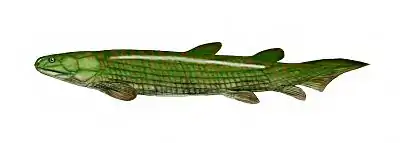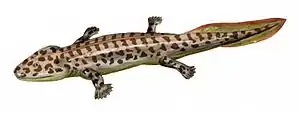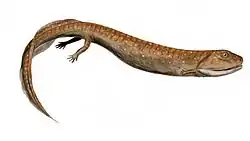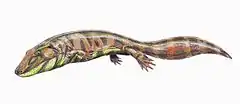Colosteidae
The Colosteidae are a family of stegocephalians (tetrapod-like vertebrates) that lived in the Carboniferous period.[1] They possessed a variety of characteristics from different tetrapod or stem-tetrapod groups, which made them historically difficult to classify. They are now considered to be part of a lineage intermediate between the earliest Devonian terrestrial vertebrates (such as Ichthyostega), and the different groups ancestral to all modern tetrapods, such as temnospondyls (possibly ancestral to modern amphibians) and reptiliomorphs (ancestral to amniotes such as mammals, reptiles, and birds).
| Colosteidae Temporal range: Middle Carboniferous | |
|---|---|
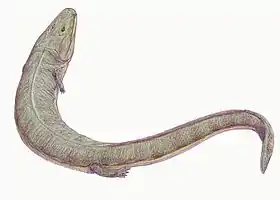 | |
| Life restoration of Greererpeton burkemorani | |
| Scientific classification | |
| Kingdom: | Animalia |
| Phylum: | Chordata |
| Clade: | Stegocephalia |
| Family: | †Colosteidae Cope, 1875 |
| Genera | |
Description
Colosteids had elongated bodies, with an estimated 40 vertebrae, not including the tail. The skull is flat and composed of many separate bones, like that of other stegocephalians. Colosteids lacked otic notches at the back of the head, unlike temnospondyls and other "labyrinthodonts". However, they did possess large mandibular and palatal fangs (on the lower jaw and the roof of the mouth) in addition to smaller marginal teeth (at the edge of the mouth), like "labyrinthodonts".The skull was overlaid with wide sensory grooves known as lateral lines, which extended from rear edge of the skull to the tip of the snout. Most aquatic stegocephalians have their lateral lines dip, unbroken, under the nostrils once they reach the tip of the snout, or alternately disconnect into separate grooves separated by the nostrils. However, colosteids evolved a unique alternative; their lateral lines droop below the nostrils so far that they contact the marginal teeth, so that the edge of the skull is responsible for subdividing the grooves, rather than the nostrils.[1]
The mandibular fangs were larger than the palatal ones, though those on the palate were still large. Colosteids were unique compared to most stegocephalians in the fact that a pair of palatal fangs were present on the premaxillary bones at the tip of the snout. In conjunction with the forward position of these fangs, the dentary bones of the lower jaw developed a notch on either side near the symphysis (chin). The symphysis itself is formed by a rough area of bone on the left and right dentaries. This rough patch is formed by a complex system of ridges, which have been described as "brassicate" (textured like a cauliflower).[2] Only Megalocephalus is known to share this brassicate patch with colosteids. The mandibles were also unique in the fact that they possessed a single elongated hole along their inner surface, known as an exomeckelian foramen (or a meckelian fenestra). Earlier stegocephalians like Ichthyostega possessed a subtle slit in the mandible, while most later groups had a series of smaller, well-defined holes.[1]
Relationships
The analysis below was conducted by Swartz in 2012, showing the relationship of colosteids with other stem-tetrapods.[3]
| Elpistostegalia |
| ||||||||||||||||||||||||||||||||||||||||||||||||||||||||||||
References
- John R. Bolt & R. Eric Lombard (2010). "Deltaherpeton hiemstrae, a New Colosteid Tetrapod from the Mississippian of Iowa". Journal of Paleontology. 84 (6): 1135–1151. doi:10.1666/10-020.1.
- Lombard, R. Eric; Bolt, John R. (September 2001). "The mandible of the primitive tetrapod Greererpeton, and the early evolution of the tetrapod lower jaw". Journal of Paleontology. 75 (5): 1016–1042. doi:10.1017/S0022336000039913. ISSN 1937-2337. JSTOR 1307064.
- Swartz, B. (2012). "A marine stem-tetrapod from the Devonian of Western North America". PLoS ONE. 7 (3): e33683. doi:10.1371/journal.pone.0033683. PMC 3308997. PMID 22448265.


